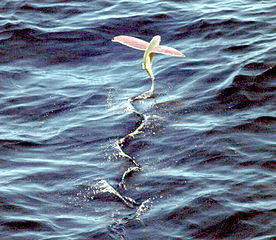
flying fish with pink wings
Flying fish are seen jumping out of warm ocean waters, the way their body is shaped, like a torpedo, enables them to gather enough speed to break the surface of water and their large wing-like fins are used to get them airborne. There are about 40 known species of flying fish, and all of them have unevenly forked tails, with the lower part longer than the upper one.
Flying fish use this gliding mechanism to escape the many predators of the sea that might be hunting them down. To be able to break the surface of water and get airborne they must first accelerate to a speed of about 60 kilometers (37 miles) an hour, while angling themselves upwards. They then begin to taxi by beating their tails rapidly while still in the water in order to break the surface. When airborne it can flap its tail to keep gliding with the help of its wing-like fins.

Flying fish from Mario
Flying fish can reach heights of up to 1.2 meters (4 feet) and gliding distances of up to 200 meters (655 feet). Flying fish have been recorded stretching out their flights with consecutive glides spanning distances up to 400 meters (1312 feet) by flapping its tail in order to taxi before actually reaching the surface of water.
Some species of flying fish have larger pelvic fins and are known as four-winged flying fish.
This gliding mechanism could be incorporated into submarines, in order to give them an evasive mechanism in order to dodge incoming torpedoes for example.
Sources :
One Comment
Lorena Barba posted on November 19, 2011 at 7:36 pm
Hi Saud,
For reference, here is EK 131 student Morgan’s post on the flying fish:
http://blogs.bu.edu/biolocomotion/2011/09/23/the-flying-fish/
It would be nice to get into a little more details about the flying characteristics of the animal.